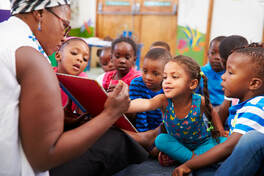Create Your Own Activities
Add the research-based key elements and key strategies to the activities you already do or create new literacy activities for children in K-3rd grade. Pilot project participants found that STEM, art, and movement activities work particularly well with Fostering Readers. Learn more by visiting the training page and the research review.

Key Elements
- Read aloud
- Book browsing and choice
- Nurture diversity
- Draw connections
- Have fun!

Key Strategies
- Read aloud interactively
- Ask the three Visual Thinking Strategies questions
- Discuss with a buddy
- Extend language
- Nurture diversity in language
Planning Templates
Use the Fostering Readers templates, or create your own, to plan your literacy activity:
- Blank template for you to fill out (Word document)
- Template with instructions embedded (Word document)
- Original template used in the pilot project (Word document)
Guidance
Please keep the following in mind:
For more guidance read the plan activities page, read the planning resources for library staff and afterschool providers, and try the extended activity plans.
- The more key elements and key strategies you include in an activity, the greater the impact on children's literacy development. Can't include them all? That's okay! One is better than none.
- Respond positively to all children's early efforts at reading and writing--they don't need to be perfect yet!
- Be flexible:
- If kids aren't having fun, change course!
- If something isn't working for you, adapt it to your style.
- If you don't think you can include all five key elements and all five key strategies in your activity, do the ones you can and go for it anyway!
- If the K-3rd grade age range doesn't work for you or the kids, narrow it down (e.g. K-1st grade)
- Fostering Readers literacy activities are fun opportunities for kids to practice reading and writing in ways that align with current research on literacy development.
- Library staff and afterschool providers support teachers by providing kids opportunities to practice what they are learning in school, often making connections between what kids learn in school and real-world applications.
- Fostering Readers literacy activities are not lesson plans for teaching children how to read.
- Don't have the capacity to do a literacy activity? Try adding the key elements and key strategies to activity stations and passive programs or beginning reader storytimes and book clubs.
For more guidance read the plan activities page, read the planning resources for library staff and afterschool providers, and try the extended activity plans.
Share Your Fostering Readers Activity Plans
Please contact us if you would like the Fostering Readers activities and handouts you create to be shared on this website. The Fostering Readers logos and style guide are available at the bottom of our Get Handouts and More page. We would like to create another page on this website to encourage Fostering Readers resource sharing among library staff and afterschool providers everywhere!
Fostering Readers is supported by the Institute of Museum and Library Services through the Library Services and Technology Act, administered by the State Library of Oregon.





